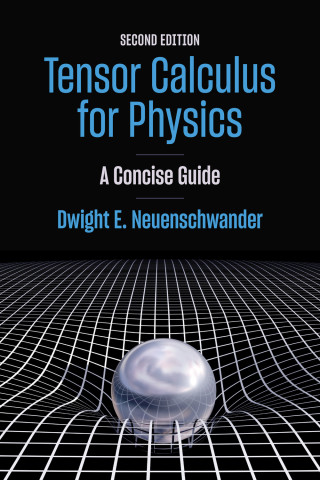
Reviews
This book is well written and has sufficient rigor to allow students to use it for independent study.
An introductory Tensor Calculus for Physics book is a most welcome addition... Professor Neuenschwander's book fills the gap in robust fashion.
Dr. Neuenschwander has written the book I wish I could have read when I was learning mathematical physics. It is colloquial yet authoritative, with many treasures lurking within the chapters. The book brings a breath-taking cohesion to the varied ideas about vectors and tensors that are typically spread across the undergraduate’s school terms haphazardly. It is the book I’ll want to have nearby next time I teach special or general relativity, or upper-level electromagnetism or rotational dynamics, as much for the historical tidbits and definitive examples, as for its asides about vocabulary and conventions and for its bibliography.
Book Details
Preface
Acknowledgments
Chapter 1. Tensors Need Context
1.1. Why Aren't Tensors Defined by What They Are?
1.2. Euclidean Vectors, without Coordinates
1.3. Derivatives of Euclidean Vectors with Respect to a
Preface
Acknowledgments
Chapter 1. Tensors Need Context
1.1. Why Aren't Tensors Defined by What They Are?
1.2. Euclidean Vectors, without Coordinates
1.3. Derivatives of Euclidean Vectors with Respect to a Scalar
1.4. The Euclidean Gradient
1.5. Euclidean Vectors, with Coordinates
1.6. Euclidean Vector Operations with and without Coordinates
1.7. Transformation Coefficients as Partial Derivatives
1.8. What Is a Theory of Relativity?
1.9. Vectors Represented as Matrices
1.10. Discussion Questions and Exercises
Chapter 2. Two-Index Tensors
2.1. The Electric Susceptibility Tensor
2.2. The Inertia Tensor
2.3. The Electric Quadrupole Tensor
2.4. The Electromagnetic Stress Tensor
2.5. Transformations of Two-Index Tensors
2.6. Finding Eigenvectors and Eigenvalues
2.7. Two-Index Tensor Components as Products of Vector Components
2.8. More Than Two Indices
2.9. Integration Measures and Tensor Densities
2.10. Discussion Questions and Exercises
Chapter 3. The Metric Tensor
3.1. The Distinction between Distance and Coordinate Displacement
3.2. Relative Motion
3.3. Upper and Lower Indices
3.4. Converting between Vectors and Duals
3.5. Contravariant, Covariant, and "Ordinary" Vectors
3.6. Tensor Algebra
3.7. Tensor Densities Revisited
3.8. Discussion Questions and Exercises
Chapter 4. Derivatives of Tensors
4.1. Signs of Trouble
4.2. The Affine Connection
4.3. The Newtonian Limit
4.4. Transformation of the Affine Connection
4.5. The Covariant Derivative
4.6. Relation of the Affine Connection to the Metric Tensor
4.7. Divergence, Curl, and Laplacian with Covariant Derivatives
4.8. Disccussion Questions and Exercises
Chapter 5. Curvature
5.1. What Is Curvature?
5.2. The Riemann Tensor
5.3. Measuring Curvature
5.4. Linearity in the Second Derivative
5.5. Discussion Questions and Exercises
Chapter 6. Covariance Applications
6.1. Covariant Electrodynamics
6.2. General Covariance and Gravitation
6.3. Discussion Questions and Exercises
Chapter 7. Tensors and Manifolds
7.1. Tangent Spaces, Charts, and Manifolds
7.2. Metrics on Manifolds and Their Tangent Spaces
7.3. Dual Basis Vectors
7.4. Derivatives of Basis Vectors and the Affine Connection
7.5. Discussion Questions and Exercises
Chapter 8. Getting Acquainted with Differential Forms
8.1. Tensors as Multilinear Forms
8.2. 1-Forms and Their Extensions
8.3. Exterior Products and Differential Forms
8.4. The Exterior Derivative
8.5. An Application to Physics: Maxwell's Equations
8.6. Integrals of Differential Forms
8.7. Discussion Questions and Exercises
Appendix A: Common Coordinate Systems
Appendix B: Theorem of Alternatives
Appendix C: Abstract Vector Spaces
Bibliography
Index






